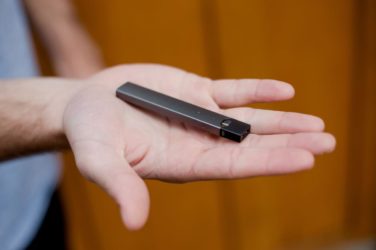Because it is October, attorneys general across the country are participating in the annual tradition of urging parents to stand vigilant against free drugs disguised as candy. This year, however, the familiar warning has gotten an update: that amid the pandemic, the US is seeing a spike in “THC overdose,” driven by edibles, among children.
On October 26, four state AGs issued such claims, all using the same data and language, which appears to have been generously pre-written for them by the Department of Homeland Security. Ohio, Illinois, Connecticut and New York (and Arkansas earlier this month) decried the dangers of youth “THC overdose” but without indicating what those dangers might be—except for New York Attorney General Letitia James, who alone of the AGs swung big:
“In light of an increase in accidental overdoses among children nationwide, it is more vital than ever that we do everything we can to curb this crisis and prevent any further harm, or even worse, death.”
This is a stunning claim, even by weed disinformation standards. To date, there is no confirmed evidence that “THC overdose” has ever killed anyone, adult or child. AG James’ office did not respond to Filter’s short-notice request for comment by publication time. This story will be updated with any comment received after publication.
I can come up with only two possible sources for her claim: The first is the 2014 case in which a college student jumped off a balcony several hours after consuming an edible and died of traumatic injury. The second is a single death among the Rocky Mountain Poison and Drug Center’s THC-involved poison control outcomes for 2018.
“1 death reported to RMPC involved polysubstance intentional overdose in which marijuana was one of the substances involved in the overdose,” notes the asterisk on that report. “Cause of death may be due to other substances.”
New York parents should be on the alert for deceptive cannabis products that look like standard snacks and candy but contain dangerously high concentrations of THC.
Any New Yorker that has encountered these products should contact my office immediately:
1-800-771-7755 pic.twitter.com/dU0Xd2RtNQ
— NY AG James (@NewYorkStateAG) October 26, 2021
There is no such thing as THC overdose, if the term describes drug consumption that causes harm like respiratory depression. “‘Overdose’ has a fairly specific meaning,” Claire Zagorski, a paramedic and coordinator for the University of Texas at Austin’s Pharmacy Addictions Research & Medicine Program, told Filter. “THC can’t achieve it.”
To be sure, kids here and there definitely get into their parents’ edibles believing them to be candy. They “overdose” in the sense that they consume more THC than intended, since the intended amount is zero.
But what almost all the press releases and media reports fail to mention is that these kids are unharmed, even in the specific cases commonly linked to as drastic examples. There is no evidence of long-term damage. There is no evidence of short-term damage, beyond physical and emotional discomfort. The effects wear off, and that’s it.
The narrative that adult-use legalization was leading to kids to THC overdose has been percolating for the past couple of years. While it is true that calls to Poison Control Centers about THC ingestion by minors have increased since the pandemic began, there is no data that harms have increased—just the volume of calls. More parents leaving edibles around the house and panicking (understandable!) when their kids eat them makes sense in the context of quarantine.
Accounts of juvenile admissions to emergency departments after accidental THC consumption fail to mention that, once there, the kids are basically left to sleep it off and then they go home. Accounts of kids ending up on ventilators fail to mention that this is a thing ED doctors do anyway, out of an abundance of caution because they’re more used to treating adults.
“THC just does not suppress breathing or anything that would get you on a ventilator. It just doesn’t,” Zagorski said. “I completely agree that a kiddo eating a handful of cannabis gummies will have a very bad time and will scare their parents, but physically they’ll be fine.”
Perhaps most egregiously, reports of harms attributed to THC overdose frequently downplay or omit the ingestion of additional substances besides THC, ones that can cause significant harm—often prescription drugs.
Medicated Nerds Ropes have killed no children, but they have pissed off the candy lobby.
As legal edibles and their packaging become more visible, critics draw analogies to the unethical youth-targeted marketing practices of predecessor industries. But the weed industry has no megaconglomerates. It has small businesses that lack the capital to do youth marketing on a mass scale even if they wanted to.
There is no credible evidence that THC consumption by minors meaningfully impairs brain development or causes long-term harms. There’s low-strength evidence of cognitive changes among adolescent smokers, and slightly more evidence in THC-exposed juvenile rats. There are certain circumstances in which it can exacerbate underlying psychiatric issues.
But none of that has to do with to one-off accidental gummy consumption. Nor does it happen on a scale that would warrant a public health response if it weren’t for the wealthy and powerful, who prop up the myths that prop up prohibition because they have vested financial interest in it.
Legal manufacturers are not out here photoshopping weed leaves into the Oreo Double Stuf logo—why would they?
Ironically, the discourse around packaging regulation exists less because of concerned parents than of corporate interests. The manufacturers of, for example, Medicated Nerds Ropes, have not killed any kids—what they have done is piss off the candy lobby. Giants like the Hershey Company lean on public health officials to support their vendettas over copyright infringement. For the sake of the children.
A number of states have paired adult-use legalization with bans on THC products that resemble candy, or may otherwise be appealing to minors. New York already has plans to regulate packaging of authorized products, including requiring it to be physically child-proof. It will also prohibit products from being deceptively marketed to youth or appearing “attractive” to youth via flavor, shape, form or name.
The examples AG James is citing aren’t subject to regulation. Legal manufacturers will not be out here photoshopping weed leaves into the Oreo Double Stuf logo—why would they? Small grey-market manufacturers with much less skin in the game can, of course, carry on with their Stoneo Double Stufs.
Legalizing marijuana for adults does not increase its use among minors—youth consumption has actually declined in direct proportion with legalization, especially at the state level. If the concern was really for the abstinence of the nation’s children, Big Candy should be lobbying for federal legalization.
Of course, if it’s more that multibillion-dollar companies are so pressed about the immense profit margins they’re surely hemorrhaging to the makers of Stoney Patch Kids, federal legalization would fix that too.
Photograph via New York Attorney General





Show Comments